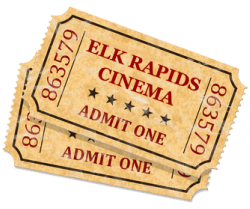History of the Elk Rapids Cinema
On September 20, 1940, the second cinema in Elk Rapids opened. It stands near the same spot as the original Community Theatre that showcased early motion pictures and live performances in this idyllic coastal town on the shores of Lake Michigan.
Known as the Elk Rapids State Theatre, it was built and operated by Mr. and Mrs. Edwin Loomis and designed by Louis C. Kingscott of the Stewart-Kingscott Company. It stands today as a beautiful example of the Art-Deco style and a historic single-screen movie house.
The Elk Rapids Cinema is home to the largest black-light mural in the world. Artist Robert Spinner originally sketched the design on graph paper, later transferring it to the ceiling where it was illuminated by ultraviolet light fixtures in the bent sconces on the walls. These sconces were custom-built by the original cinema owner, who created the clear and curved Lucite tubes over the kitchen range in his home. There are six of these unique lamps.
The light-play continued to the fluoresced aisle-carpets where they too shined, brightened by rectangular fixtures in the ceiling.
The original control booth boasted two Brenkert BX 80 Arc Lamp projectors side-by-side. When the Cinema played the original 3-D format, both projectors would be running at the same time. Two metal buckets were fixed to the floor where projectionists could toss hot-spent carbon rods from the lamps.
The second owners of the building were Mr. and Mrs. Howard Coddington of Traverse City who became stewards in July of 1960 and officially changed the name, simply, to the Cinema. They expressed interest in showing foreign films along with first-run features.
In those days, a technicolored “Cinema” sign hung outside on the front light fixture and neon lit up the marquee. A truck also ran into the front of the building, but that’s a different story.
The following pictures were taken on opening day in 1940. Click on the thumbnails below for a larger image...
Known as the Elk Rapids State Theatre, it was built and operated by Mr. and Mrs. Edwin Loomis and designed by Louis C. Kingscott of the Stewart-Kingscott Company. It stands today as a beautiful example of the Art-Deco style and a historic single-screen movie house.
The Elk Rapids Cinema is home to the largest black-light mural in the world. Artist Robert Spinner originally sketched the design on graph paper, later transferring it to the ceiling where it was illuminated by ultraviolet light fixtures in the bent sconces on the walls. These sconces were custom-built by the original cinema owner, who created the clear and curved Lucite tubes over the kitchen range in his home. There are six of these unique lamps.
The light-play continued to the fluoresced aisle-carpets where they too shined, brightened by rectangular fixtures in the ceiling.
The original control booth boasted two Brenkert BX 80 Arc Lamp projectors side-by-side. When the Cinema played the original 3-D format, both projectors would be running at the same time. Two metal buckets were fixed to the floor where projectionists could toss hot-spent carbon rods from the lamps.
The second owners of the building were Mr. and Mrs. Howard Coddington of Traverse City who became stewards in July of 1960 and officially changed the name, simply, to the Cinema. They expressed interest in showing foreign films along with first-run features.
In those days, a technicolored “Cinema” sign hung outside on the front light fixture and neon lit up the marquee. A truck also ran into the front of the building, but that’s a different story.
The following pictures were taken on opening day in 1940. Click on the thumbnails below for a larger image...
The Cinema's third owner, Joe Yuchasz, bought the art deco movie theater from the Coddingtons in 1973. "Fiddler on the Roof" was his first picture, and he showed it again during a celebration of the Cinema’s 75th anniversary.
“There's no remote-control manager in this,” he told the Traverse City Record-Eagle in 2008. “You're the secretary, treasurer, janitor and the emergency repairman.”
The story of the Cinema is inseparable from Yuchasz’s life story. The single-screen movie house opened as the State Theater in 1940, the year he was born. After his family moved to Kewadin in 1946, they became frequent patrons.
“I guess if I had my druthers, I’d do nothing but run this theater,” he told the Detroit Free Press in 1984.
Yuchasz persisted, even if changes to the movie business meant that the margins were sometimes tight. Over the years, he added plush seats, upgraded the sound system, installed a state-of-the-art digital projector and, most recently, a new popcorn machine.
His relationship with the Cinema was a love story good enough for the silver screen. But he was also animated by a deep affection for his community. He was a flurry of activity, at times running a music store and a T-shirt shop as well as the theater. He was an active member of Rotary. He served as village president from 1985 to 2006 — a period in which the Elk Rapids harbor was expanded twice. He told the Elk Rapids News that it was his proudest accomplishment.
Yuchasz had a special interest in education, working for years as a high school teacher in Elk Rapids and Bellaire. He taught piano lessons from the Cinema's lobby, and he often staffed the theater with high schoolers, to whom he would provide mentorship as well as a wage.
Yuchasz passed away on January 18, 2023, almost exactly 50 years after he purchased the Cinema.
This video tribute was created by former Cinema employee Dustin Heger.
Portions of this history of the Elk Rapids Cinema were written by Joseph Beyer and are used here with his permission and our gratitude. Other portions were written by Joe Yuchasz's nephew Brian J. Bowe.






